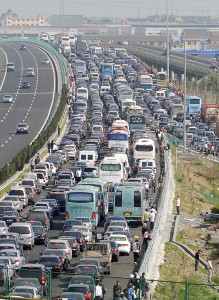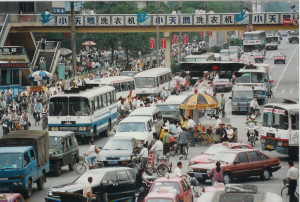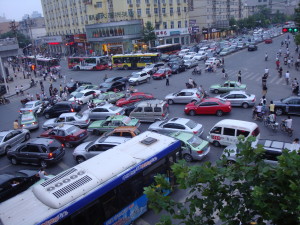 In the European Chamber’s Executive Position Paper 2013/2014, we made three main recommendations to the Chinese Government. One of these was to adopt a more systemic approach to overcoming challenges and problem solving, but what exactly does this mean? Mats Harborn, Vice President of the Chamber and Vice Chair of the Chamber’s Automotive Working Group provides an explanation and puts this recommendation into context with some smart examples.
In the European Chamber’s Executive Position Paper 2013/2014, we made three main recommendations to the Chinese Government. One of these was to adopt a more systemic approach to overcoming challenges and problem solving, but what exactly does this mean? Mats Harborn, Vice President of the Chamber and Vice Chair of the Chamber’s Automotive Working Group provides an explanation and puts this recommendation into context with some smart examples.
In China, as in many countries around the world, there is an over reliance on complicated, state of the art and expensive technologies to solve problems. This often occurs because the benefits of taking a holistic view are not immediate enough; the temptation is to quickly arrive at a conclusion and then spend time and effort trying to find a solution. Despite being expensive and inefficient, this approach is sometimes encouraged by governments that believe they can dictate solutions to (incorrectly) perceived problems.
It is far more preferable to place problems in a larger context and carefully analyse how they are influenced by other external factors. Instead of dictating a solution it is healthier and more efficient to set a goal or target and then encourage society and the market to create solutions. This approach can be illustrated by using examples that we all can relate to.
Traffic congestion
 An immediate conclusion to the problem of traffic congestion is that either there are too many cars, or too few roads; quick solutions may be to invest in more roads or introduce a congestion fee. However, the problem may be caused by built-in bottlenecks within the existing road system.
An immediate conclusion to the problem of traffic congestion is that either there are too many cars, or too few roads; quick solutions may be to invest in more roads or introduce a congestion fee. However, the problem may be caused by built-in bottlenecks within the existing road system.
An important goal in planning traffic is to ensure a smooth flow as disruptions quickly lead to jams. If, for example, an exit from a ring road has been badly designed (this can be seen everywhere in China where the entrances to and exits from major arteries are constructed within a few metres of each other) traffic cannot easily flow to and from adjacent roads. This leads to traffic jams both on the ring road and on the adjacent road.
Poorly synchronised traffic lights can also cause serious congestion, and even something as simple as road sign placement can cause disruptions to the flow of traffic. For example, if a road has poorly placed or insufficient signage a driver may need to slow down in order to ascertain the correct exit. This will cause vehicles behind him to brake leading to an accumulation of traffic. This clearly demonstrates the benefits of taking time to analyse the bigger picture—it is far cheaper to increase and improve the placement of signage than it is to construct a new road.
Air pollution
In many Chinese cities air pollution is a serious challenge. Because they emit exhaust fumes cars are visible and obvious contributors to the problem and are easy targets to blame. However, while they certainly contribute there are bigger culprits.
A major source of air pollution is the process of heating and cooling buildings. It is extremely important to build energy-efficient buildings, particularly in areas where there is a frenzy of construction activity. In China there is a wealth of construction standards but very little enforcement. This frequently results in buildings being constructed with sub-standard materials, single-glazed windows and no heating-control systems.
Maintaining an optimum temperature in these kinds of buildings results in huge amounts of energy wastage: because they are fed a surfeit of energy to compensate for their poor insulation, the lack of a control system means the only way to regulate the temperature is to vent by allowing the excess heat to escape—it is far too common a sight to see buildings in the north of China with the windows wide open in the height of winter.
A recent report showed that if all single-glazed windows in China were replaced with double glazing a staggering 20 per cent of the total energy used for heating could be saved.
The housing challenge in China has been solved for hundreds of millions of people, but a lack of enforcement of constructions standards and a lack of energy-conserving technologies has resulted in buildings that are inefficient and adversely affect the air quality. It is a huge concern that many new, poorly constructed buildings will stand for many tens of years to come and thereby continue to contribute to this most serious of problems.
 Traffic safety
Traffic safety
The Swedish Government set a target of zero fatal accidents. It was identified that a significant step towards achieving this would be the separation of opposing lanes, but in a country with an abundance of class one highways (roads that do not have an existing separation between opposing lanes) an immediate solution did not appear simple or cheap. Roads could be widened to allow for a central reservation to be constructed, but this would entail huge costs to society.
The smart solution was to separate the opposing lanes without widening the roads using soft wire fencing, and to reconfigure the road layout into alternating two-lane sections. This means that traffic in each direction has lengths of road with two lanes where it is safe to overtake, before reverting back to a single lane. Drivers drive more calmly in these single-lane sections because they know that in a couple of kilometres the road will revert back to two lanes and they will once again have the opportunity to overtake if they need to.
This small but clever solution achieved both a better traffic flow and helped to reduce fatalities on the road.
 Conclusions
Conclusions
When a problem is identified it is important to set a clear vision of what should actually be achieved by solving it. This vision or goal needs to be clearly communicated so that the stakeholders can begin working towards the best solution. This process is the foundation of creative and innovative thinking.
It is not feasible for one person, or even a single ministry, to provide answers to our problems. Instead, it is the role of government to articulate goals and then trust society and the market to generate efficient solutions. This entails governments understanding how issues are interconnected and leveraging all relevant stakeholders instead of relying on inefficient silo management. All ministries and government agencies need to strive towards the same goals and seek cross-departmental cooperation and coordination to facilitate the most efficient solutions.
In today’s complex world there is increased interaction between people, services and processes that were previously unrelated, and this illustrates why standardisation is integral to providing efficient solutions. A standard has no purpose in itself, but it exists to ensure the development of common interfaces in all aspects of society, from the smallest to the largest. To be meaningful a standard should serve a specific purpose, and its users should be involved in its design from the beginning through to its implementation.
It is tempting for a developing nation to allow the government alone to write all standards and to just base them on existing standards from other countries. The problem is that such ‘copies’ are not developed with a clear understanding of the underlying principles of the particular standard, which leads to a lack of understanding of how to adhere to or enforce it.
Europe and European industry wants to partner China in this important area but often companies find it difficult to do business here as the products or services they offer are usually developed as a complete system solutions, or at least as part of a system solution. The wish of European companies is to offer more value than just the cost of the product or service alone, but when these products or services are viewed in isolation from the system that they were created for they may appear expensive or irrelevant. It is therefore in the interests of European industry to encourage China to move towards systemic approaches, which in turn will benefit China as its consumers will begin to see the emergence cheaper and more efficient solutions.


Recent Comments